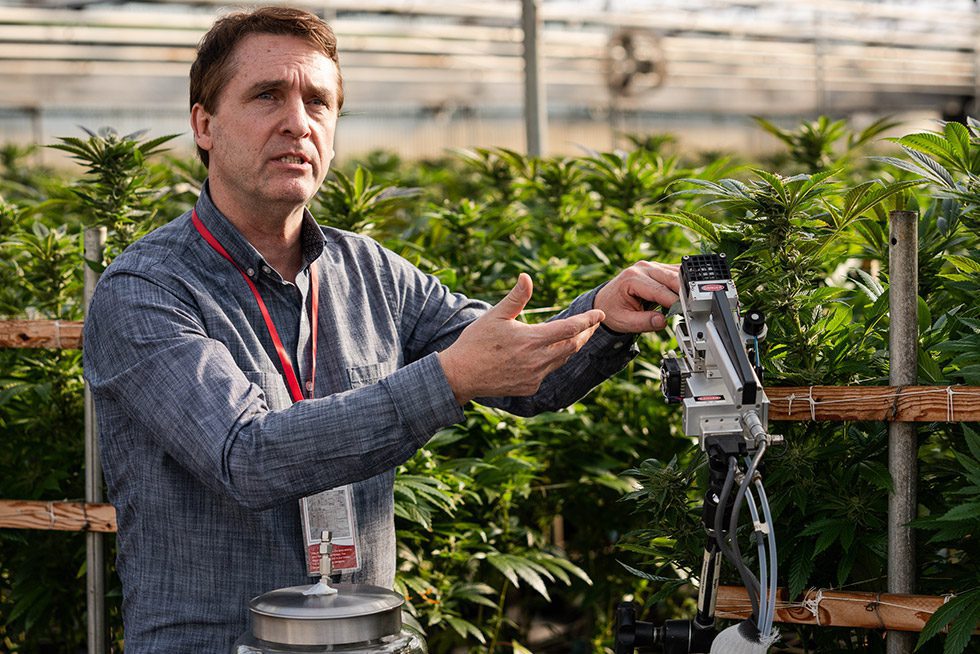
Byers Emissions Analysis developed a scientific and mathematical approach for quantifying odor coming from Cannabis plant emissions at a given facility. Our lead scientists, Dr. Will Vizuete and Dr. Alex Guenther, head a team focused on Cannabis biogenic volatile organic compounds (BVOCs) research and seeking a molecular-level understanding of odor and air quality for the Cannabis space. Through these efforts, we collaborate with cultivators to develop a robust odor abatement plan that deploys the best available technology for informing compliance preparedness with air quality and odor.
As community complaints of Cannabis odor rise across the country, we help cultivators prepare for and resolve their individual emissions issues with data and technology to efficiently, effectively, and sustainably operate without interruption.
Why is our bottom-up approach of capturing and calculating your canopy emissions profile the essential first step for odor control?
Here are 5 reasons to consider when answering that question:
1. HVAC Companies Are Ill-Equipped for Cannabis Odor Management.
There is a perpetual reliance on HVAC systems—specifically in hybrid-greenhouses, warehouses, and indoor cultivation spaces—that are not engineered for Cannabis odor control to sequester odor molecules. HVAC companies are experts in environmental controls such as temperature, CO2 regulation, and dehumidification to ensure the ideal environment for growing Cannabis. Odor control at this scale and at these concentrations of molecules needs to be tasked to proven odor mitigation experts and backed by science.
2. Cannabis Odor Is a Complex Issue.
The emissions coming off the Cannabis plant are comprised of monoterpenes, sesquiterpenes, thiols, and other complex compounds, making up over 200 molecules. Like other recent studies on the topic, our research has identified the compound 3-Methyl, 2-Butene, 1-Thiol as a potential contributor to the common odor from Cannabis. Byers Emissions Analysis is developing the methods and techniques to identify and quantify that compound along with several others specific to Cannabis, as we have found many other thiols emitted from the plant. It appears that there is no singular molecule causing the ‘skunk-like’ smell, so Byers Emissions Analysis comprehensively measures all the complex emissions coming from the plant using the Leaf Enclosure Method. This method, which was engineered for Cannabis by our very own Dr. Alex Guenther, allows us to capture and analyze the types and quantities of site-specific terpenes. We can then calculate emission factors for each of these site-specific molecules to allow for measurable impacts to outdoor and indoor air quality from Cannabis. These estimated emission factors are necessary to build emission inventories for future air quality, odor or terpene drift assessments.
3. Cannabis Emission Rates Are Highly Variable.
Our studies show considerable variability in the rate and composition of terpenes and other compound emissions across different Cannabis strains and even among the same strains. As a solution, our team of scientists quantifies your canopy’s gas-phase emission rate based on the number of strains, plant count, life stage, and estimated plant weight.
4. Knowing Your Canopy Emissions Profile Empowers Efficient Odor Mitigation.
Using the gas-phase emission rate from the collected canopy data, we can determine the exact number of air exchanges required to effectively sequester the odor molecules before they have a chance to be released to ambient air and potentially be a nuisance to nearby communities. We then plug these volumetric measurements into our Cannabis Emissions Profiler™ (CPS) to identify the CFM required for the optimal number of air exchanges and properly size equipment to mitigate the odor efficiently.
For example, it can be determined that a cultivation space that is 225,000 ft3, requires two (2) 6,000 cfm molecular filtration systems (i.e., 12,000 cfm), which equals ~3 air exchanges/hour.
5. Efficient Odor Management Enhances Sustainability.
By installing the proper number of molecular filtration units running the optimal number of air exchanges to effectively remove odor, a cultivation operation will save on equipment costs, unnecessary energy usage (associated with over-scrubbing), waste associated with ineffective or spent carbon media and liability costs from community odor complaints. This bottom-up approach to odor mitigation by first assessing a canopy’s emission profile results in a more environmentally and socially sustainable operation.
Byers Scientific’s custom-engineered odor mitigation solutions are proven to effectively neutralize odor for commercial marijuana cultivation, manufacturing, and processing, as well as industrial hemp cultivation, manufacturing, and processing. Our Byers Emissions Analysis team empowers compliance by helping commercial cultivators first identify, measure, model, and assess their canopy emissions profile to right-fit odor mitigation strategies and solutions before plant emissions become a liability.

